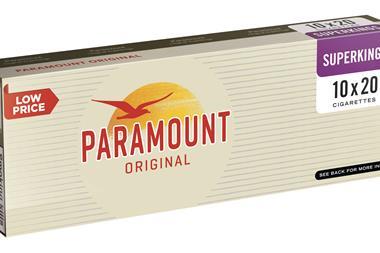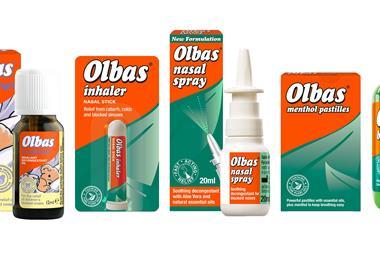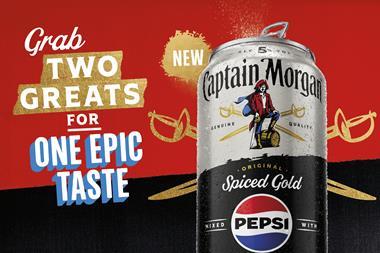Tobacco continues to be perhaps the most testing and controversial product category that UK retailers have to deal with on a daily basis.
However, despite the ever-increasing challenges associated with legislation, illicit stock, escalating prices and the economic downturn, the category has remained enormously resilient. More than 13.1m UK adults still choose to smoke, and volumes slipped only slightly in the 12 months to October 2008, according to AC Nielsen data.
However, drill down a bit further and it quickly becomes apparent that a real sea change is occurring within the category.
While cigarette sales are down year on year, sales of Roll Your Own (RYO) tobacco and filter tips are soaring, as shoppers look for cheaper options.
The figures concerning men and women smokers also make interesting reading. While the number of male smokers has fallen by 1.5%, the number of female smokers has grown by 1.2% as more women look to the tobacco category for help with stress and weight management.
Tobacco products account for a staggering 12 of the UK’s top 20 fastest moving consumer goods brands, and nowhere are tobacco sales more important than c-stores - particularly those owned by independent retailers.
Tobacco sales represent about a third of total annual turnover in the average independent store, and nearly a fifth of its profit.
Adult smokers are also incredibly loyal to their local stores, visiting much more frequently than non-smokers and spending more per visit, too. In fact, a typical adult cigarette smoker has been found to visit an independent store up to five times a week, and spends more than £8 per visit, adding up to an average of £31.20 turnover per adult smoker per week - a pretty significant figure, it must be agreed.
And despite the testing market conditions, manufacturers remain bullish about the category’s prospects in years to come - even if, and it still remains an if, the tobacco display ban is enforced.
“Tobacco remains a legal product enjoyed by millions of adult smokers in the UK,” says Ronan Barry, head of corporate and regulatory affairs at British American Tobacco (BAT). “For as long as there is demand, there will be a requirement for a legal, responsible and highly regulated supply chain.”
Cigarettes
The UK market for cigarettes dipped by 3.8% in the 12 months to October 2008 as changes to legislation and the economy took their toll.
However, despite the fall, the total cigarettes category is still worth £11.7bn. Regular readers of Convenience Store will be well aware of the down-trading dynamic which has been shaping the category for the past three years, and this trend has accelerated of late as purse strings have tightened.
Sales of economy-priced cigarettes have ballooned by 18% since 2007, while sales of value- priced brands - the largest segment in the cigarette category - have jumped by 2.3%.
In fact, more than 45% of cigarette sales currently come from the lower-priced sectors, and this figure is expected to increase in 2009 and beyond, as higher taxes and the economy force smokers to try cheaper options.
Forecasts from Imperial Tobacco suggest that by 2011 well over 50% of cigarette sales will come from lower-priced brands.
This prediction has prompted a number of the UK’s key manufacturers to launch new products into the sector.
The end of 2008 saw Imperial Tobacco launch new economy brand JPS Silver in both plain and pricemarked packs. The brand, which is available in standard, Kingsize and Menthol packs of 10 and 20 has already achieved more than £40m-worth of sales since its November launch.
The end of 2008 also saw Japan Tobacco International (JTI), formerly Gallaher, realign the price of its Sterling cigarette brand into the ‘super value’ price sector. The move followed a successful pricemarked pack promotion that grew Sterling’s share of the super- value sector and lifted its share of the UK cigarette market from 5% to 6.1% in just over four months.
So what does the growing dominance of cheaper variants mean for more premium cigarettes?
While the category is in decline, the 2.6% fall in sales is not as severe as it could have been - largely because the type of adults who choose to smoke premium brands tend to be the least price sensitive. Imperial Tobacco UK trade communications manager Iain Watkins says the segment’s resilience is great news for retailers, as premium products constitute the meatiest part of their turnover.
“About a quarter of total UK cigarette sales are accounted for by brands from the premium price sector, and over the past year this sector has lost only less than 1% of the market despite the tough economic climate affecting the country,” he says.
“The value of the premium sector is three times that of the economy-priced sector. Offering significant retail margins, renowned brands such as Embassy, Regal and Marlboro remain vital elements of the retail mix.”
And JTI has also proved how valuable it believes the premium-priced sector to be by launching a range of five limited-edition designs for its premium lower-tar cigarette brand Silk Cut. The designs revolve around the ‘Cut’ theme and feature five variations including Diamond Cut, Power Cut, Short Cut, Precision Cut and Director’s Cut. They are available across Silk Cut Purple 10s and 20s, Blue 20s, and Silver 10s and 20s.
It’s not the only manufacturer backing the premium offer. BAT has invested in a flashy new packaging redesign for its Lucky Strike brand. Lucky Strike Silver now features new blue bull’s-eye packaging to help smokers better differentiate between its two blends.
The blue colouring is thought to better denote the brand’s more mellow taste, while Lucky Strike’s original full flavour (10mg) remains in a red pack.
The cigarette brands to have taken the biggest hit of late are those that fit in the mid-priced sector of the gantry.
Sales of mid-priced cigarettes fell by 8.8% in the 12 months to October 2008 and this figure is forecast to grow as smokers continue to downtrade. Only two of the best-selling mid-priced cigarettes showed growth in the 12 months to October 2008: Imperial Tobacco’s Superkings and Superkings Blue.
Interestingly, the past few months have also seen a marginal increase in sales of menthol cigarettes, with the minty sticks now accounting for 6.7% (+0.2%) of the cigarette market when segmented by tar level and taste. The rise has been attributed to the increased number of female smokers, and a desire to smell less of cigarette smoke since the ban on smoking in public places.
Keen to profit from the trend, JTI recently launched Silk Cut Menthol. The brand, which was launched across all channels in December 2008, is already proving to be a big hit with female smokers.
The growing popularity of menthol is also likely to open a window of opportunity for other flavoured products, and one company hoping to profit from this is Djarum, the Indonesia-based company which manufactures the famous clove cigarette, or kretek.
Initially, Djarum cigarettes were available only in specialist tobacco shops such as Davidoff, JJ Fox, Shervington, Selfridges and Harrods.
However, the business is now targeting the convenience store sector in a big way following a surge in sales. The company is proving increasingly popular with foreigners living and working in the UK who have previously smoked Djarum in their home countries, mainly Americans, but also Polish, Spanish, Austrians, Germans, and Turkish nationals.
Roll Your Own
The rise and rise of the RYO market has been the big success story where tobacco is concerned. After six years of progressive growth, it took off in 2008 with retail volumes increasing by more than 11%.
The RYO success story can be attributed to a number of factors, not least of which is the credit crunch, as shoppers counting their pennies look for cheaper ways to smoke.
“Whichever way you look at it, RYO offers adult smokers astoundingly good value for money,” says Imperial Tobacco’s Watkins. “A 12.5g pack of RYO tobacco can make up to 28 cigarettes, which is fantastic value for money, and it’s a genuine, legal proposition.”
RYO, which used to be almost exclusively smoked by men, has also managed to make itself more attractive to the fairer sex. According to research by Imperial Tobacco, almost 10% of all female smokers now regularly smoke RYO products, and that figure is set to keep on rising as more women wake up to the fact that, unlike other tobacco products, RYO allows them almost total control over the quantity smoked.
It has also managed to dress itself up with a ‘cool’ image, as Zig-Zag managing director Andrew Armstrong explains: “There used to be a social stigma attached to handrolling, but that has been bypassed now.”
The past six months have also seen a wealth of new product development and investment in the RYO sector, and smokers now have a sizeable range of options to choose from.
The prize for the biggest and brightest launch has to go to Imperial Tobacco, which woke up the industry with the launch of Golden Virginia Yellow last autumn. The launch - which was the first Golden Virginia brand extension in 130 years - was designed to target smokers who wanted to trade down rather than give up. It was first made available in 12.5g, 25g and 50g packs with rrps of £2.73, £5.35 and £10.59 respectively - considerably cheaper than the £2.99, £5.87 and £11.62 price tags for original Golden Virginia.
Meanwhile, JTI has also been busy investing in its top-selling Amber Leaf brand, marking the
10-year anniversary of the 12.5g flip top pack by launching a limited- edition design.
And as smokers continue to look for even greater value for money, demand for larger pack sizes such as 25g and 50g packs is also increasing. The popularity of 50g packs has continued to grow since 2007, and the size now accounts for 17.6% of the market. The 25g packs have also shown a slight increase in popularity - up 0.5% to claim a 33.5% share. While still claiming the largest slice of market share, the smaller 12.5g packs have seen their popularity dip of late as smokers look for greater value for money.
The recent decline in illegal RYO sales has also helped boost the legitimate market. More joined-up thinking between government departments, manufacturers, HM Revenue and Customs and UK border control has meant that the UK RYO market is now much less susceptible to the twin threats of counterfeiting and smuggling, and as a result genuine UK duty-paid volumes have soared.
The success of RYO is not just limited to tobacco, either. Sales of filter tips are also on the increase as more cigarette smokers, who are used to the feel of a filter, choose to dual between cigarettes and RYO.
Nielsen data for the year to December 2008 places the total value of the filter tips market at more than £32m - £3.3m more than in 2007. And in terms of volume, sales through independents account for 33.9% of all filters sold in the UK.
Republic Technologies (formerly Swedish Match) has invested heavily in promotional activity for its Swan brand of late, and particularly for its recent Pop A Tip variant. It also launched the more premium Swan Smooth brand at the end of 2008, and the company believes that retailers, and particularly independents, should take the category more seriously.
The rolling papers category has also continued to perform admirably, with adult smokers currently spending almost £109m on them annually. More than 50% of all rolling paper sales are made in convenience stores, and Imperial Tobacco’s Rizla brand accounts for almost three-quarters of them. Half of total sales are attributable to Rizla Regular Green, a brand worth just under £39m to retailers.
Cigars
The cigar market continued to experience a decline in both volume and value in the year ending October 2008 as further increases in tobacco excise duty, the recession and changes in consumer smoking behaviour took their toll.
All but four of the top 10 cigar brands experienced a fall in demand, and the small cigar sector was the hardest hit, with an 18% drop in volume and 15.6% fall in value down to £299.7m.
Large cigars fared only slightly better, experiencing a 10% fall in volume and value. In fact, the only category which, for now, appears to be resisting decline is miniatures. The minis market continues to account for more than 50% of the total cigar market, and this figure is predicted to reach 56.5% by 2011 as more cigar smokers move into this segment.
Migration into the minis market is happening for a number of reasons, the most prevalent of which is a change in smoking behaviour brought about by the ban on smoking in public places.
James Higgs of Henri Wintermans UK points out: “It’s simply not easy or convenient for a smoker to enjoy a large cigar while standing on the pavement, so a miniature cigar is the perfect trade- off to this restriction.”
Keen to profit further from the success of miniatures, Henri Wintermans recently introduced Café Crème Express. Express is smaller than traditional miniature cigars, allowing adult smokers to enjoy a “moment of pleasure, even if they are time-poor or in a restricted venue”.
Café Crème Express is available in two variants, Original and Blue. A third variant, Arome, is set to follow in the near future.
However, despite their respective declines, manufacturers are urging retailers not to give up on the larger cigar sectors. The large cigar segment, normally associated with special occasions, is still very popular during the Christmas period and retailers are advised to continue stocking best-selling brands in order to capitalise on this seasonal profit opportunity.
Smuggling
Despite efforts by retailers, tobacco manufacturers and HM Revenue and Customs (HMRC), the illegal tobacco trade remains big business in the UK. The last available figures from HMRC estimate that in 2007 up to 17% of cigarettes and 59% of RYO tobacco smoked in the UK were smuggled - a huge loss to the industry and also to the Treasury.
And it looks like it could be about to get worse. Retailers fear a substantial rise in the amount of smuggled tobacco on UK streets if the government presses ahead with a ban the display of tobacco products. Their fears could be well founded. Less than a year after the Canadian province of Ontario introduced a display ban, more than 50% of tobacco sales are being made through illegal sources, leaving small legitimate retailers dead in the water.
The squeeze on consumer spending and the spiralling levels of tobacco tax won’t help, either. Despite huge pressure from the industry, the Chancellor still decided to increase tobacco taxes by a further 2% in the 2009 Budget. Commenting on the decision, Tobacco Manufacturers’ Association (TMA) chief executive Christopher Ogden said: “The increase in tobacco tax helps to maintain the UK’s position as one of the world’s most profitable destinations for tobacco smugglers and this is of great concern to the TMA and its member companies.”
However, there is a light, albeit a small one, piercing through the gloom. HMRC and the newly-formed UK Border Agency are making dents in criminals’ operations - demonstrated by the seizure of 1.9bn cigarettes and more than 225 tonnes of RYO tobacco in 2006/7.
Just last month JTI and Philip Morris International signed a ground-breaking 15-year agreement with the European Commission and 26 Member States of the EU to work together in combating the illegal trade of cigarettes in the European territory.
Meanwhile, new technology which quickly identifies whether tobacco stock is genuine and duty- paid is now being used by trading standards officers across the UK.
And there’s a lot that retailers can do, too. Simply by reporting any suspicions they may have about illicit trade in their area, retailers can make a real dent in criminal operations.
Information can be reported on the Customs Hotline: freephone 0800 595 000; or the JTI hotline: freephone 0800 181 519.
Stocking advice
Avoiding out-of-stock situations for leading cigarette brands is vital for independent retailers, particularly since research has shown that 67% of adult smokers will leave a store if their brand of choice is not available.
Research has shown that the average independent retailer’s tobacco out-of-stock rate is 5.5% - costing them a staggering £2,400 in turnover a year - equivalent to closing the store for three days.
The tobacco market is also subject to huge regional variances, meaning that it is vital for retailers to speak regularly to sales representatives about what’s hot and what’s not in their local market.
For example, the best-selling cigarette brand in Scotland is Lambert & Butler King Size, but in East Anglia smokers prefer Mayfair. Adult smokers in Greater London, meanwhile, have another brand of choice - Benson & Hedges Gold King Size.
retailer opinion
“Cigarette sales have generally stood their ground, which is good news being a CTN. I am worried about the amount of bootlegging in my area, though, and fear that smokers might be tempted to try this route in the recession.
“The lower-priced cigarettes, especially those in pricemarked packs, are selling really well, but bizarrely I’ve also seen an uplift in sales of more premium cigarette brands recently.
“This has been fuelled by smokers who had switched to lower-price brands in a bid to save a bit of cash, but then came back to the more premium section after being dissatisfied with the taste.
“The growth in RYO and filters has also been amazing to watch. My sales have grown by more than a third since this time last year. This is mainly being driven by smokers who used to dabble in RYO now smoking it on a regular basis.
“My tip to any retailer looking to get the most out of his or her tobacco gantry is to stock the leading brands in all price segments, and play close attention to any deals. Buying well really is the key to success in this climate.”
Hitesh Pandya, Toni’s News, Ramsgate, Kent
Grocery channels’ share of the cigarette category
Independent convenience 37.5%
Multiple grocers 30.2%
Multiple convenience 15.5%
Forecourts 11.4%
Multiple off-licences 2.8%
Independent off-licences 2.0%
Pubs 0.4%
Other on-licensed 0.2%
Grocery channels’ share of the RYO category
Independent convenience 35.5%
Multiple grocers 32.4%
Multiple convenience 16.2%
Forecourts 10.8%
Multiple off-licences 2.4%
Independent off-licences 1.8%
Pubs 0.6%
Other on-licensed 0.3%
Chart toppers
Cigarettes
Lambert & Butler King Size
The number one cigarette brand made its first appearance here in 1979 when it cost 61p for a pack of 20. Since then the brand has seen range extensions and packaging redesigns, the most recent of which was a shiny holographic pack to mark 10 years at the top. The brand has a 13.1% share of sales.
tel: 0117 963 6636
RYO
Golden Virginia
With a 44.3% share of sales, Golden Virginia is the UK number one handrolling tobacco. It is sold in more than 35 countries, with its key markets being Belgium, UK, Spain and Luxembourg. The brand recently launched its first brand extension for 130 years, Golden Virginia Yellow.
tel: 0117 963 6636
Cigars
Hamlet
Since 1964 Hamlet has been delivering more profit to the trade than any other brand in its class, generating £135m in retail sales last year alone, and a 23.1% share of all cigar sales. Last December JTI introduced half-outers of Hamlet 5s permanently in the wholesale trade.
tel: 0800 163 503
Tobacco alternatives
The past year has seen an explosion of alternative tobacco products which offer smokers ways of “getting round” the ban on smoking in public places and a “cheaper” way to smoke.
The first of these was the electronic cigarette. The smokeless sticks use replaceable cartridges with shots of nicotine to give adults an indoor-legal alternative to tobacco. As well as their “healthier” status, manufacturers of the electronic cigarettes are also playing heavily on the cost-saving associated with their products.
Intellicig commercial director David Newns says that a 20-a-day smoker could see a saving of 75% if they switched to electronic product. An Intellicig pack retails from £15, and a cartridge lasts eight times as long as standard cigarettes, resulting in an average saving of £1,500 over a year.
Another product looking to profit from the tobacco market’s difficulties is Liquid Smoking. The drink contains an African herbal extract that provides “a slight energising effect”, followed by a “euphoric sense of calming and relaxation”. The product, which contains nicotine and is high in vitamin C, was introduced in the UK in October after achieving strong sales in the Netherlands.
Another product that is experiencing a surge in sales is Nicogel. The tobacco-based gel, which was originally designed to help smokers on long-haul flights, is reporting a huge rise in
sales since the ban on smoking in public places.
preventing underages sales
If there is any doubt about the age of the customer, always ask to see valid photo proof of age
Train your staff in this policy; keep a record of the training and when it was done. Repeat the training at regular intervals
Keep a refusals or incident log. Check this periodically; it will show you if there are members of staff who rarely refuse sales. This might mean that additional training is required.
The law and you
Health warnings
The score: Retailers, wholesalers and manufacturers who flout the law will face a fine of up to £5,000.
The law: Pictorial Health Warnings (PHWs) started appearing in the supply chain in November 2008, and retailers should now find that their fastest-selling cigarette brands will have PHWs on the back of packs.
From October 1, 2009, it will be an offence to sell any cigarette packs without the new PHWs on them, so effective stock rotation is now key. The legislation does, however, recognise that some tobacco products take longer to sell through, so retailers have until September 30, 2010 to sell through cigars, RYO tobacco and pipe tobacco with the current text warnings on the reverse.
Negative licensing
The score: April 1, 2009 saw the introduction of two new penalties for retailers in England and Wales who are caught by Trading Standards selling tobacco products to under-18s three times in a two-year period.
These penalties are in addition to the £2,500 fine which already exists.
The law: The two penalties are: Restricted Sales Order, which prevents an individual from selling tobacco products or accessories for up to 12 months;
and Restricted Premises Order, which stops a particular premises from selling tobacco products or accessories for up to 12 months.
Health Bill (England and Wales)
The score: The government published
the proposed Health Bill in January 2009 that contained measures to ban the display of tobacco products in retail premises. The Bill is now due for debate by MPs in the House of Commons, and retailers are urged to contact their local representative with any concerns that they have about the proposal.
The law: If the ban receives Royal Assent, small stores will have until 2013 to make the changes necessary to their gantries. Large stores and supermarkets will have to do so by 2011.
A proposal to make plain packaging of tobacco mandatory was defeated in the House of Lords earlier this month.
Health Bill (Scotland)
The score: On February 26, 2009 the Public Health Minister in Scotland published the Tobacco and Primary Medical Services (Scotland) Bill.
The proposals include: banning the display of tobacco and smoking-related products in shops; introducing a registration scheme for retailers; giving trading standards officers powers to issue fixed penalty notices for retailers who sell cigarettes to under-18s; and banning orders to prevent retailers selling cigarettes if they continually break the law.























No comments yet